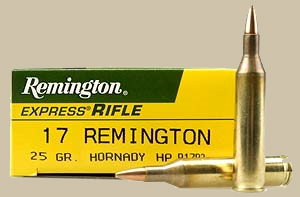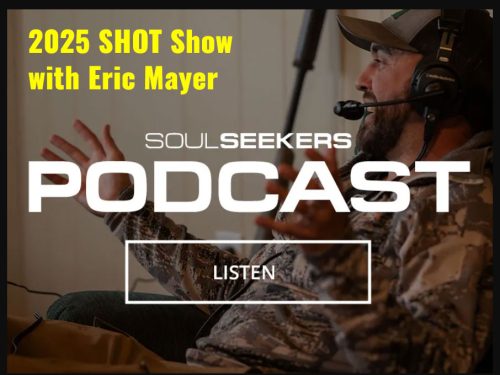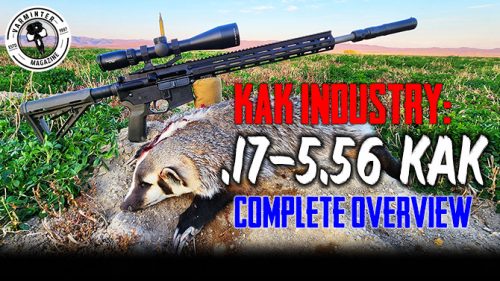If you listen to most outdoor writers today, they will tell you that in your quest to find the ultimate Varmint rifle you should stay away from the .17 Remington. They give reasons like, “it’s to hard to load for”, “the bullets are too light”, “the barrels foul to easily” and my favorite “the .17 only allows for marginal kills”. I am here to tell you different. This isn’t taken from stories I’ve heard, this is taken from over 9 years of loading and shooting the .17 Remington. I have shot countless animals from Ground Squirrel sized game, to Rock Chuck to Predators, so I can truly say that I have experience with this caliber. I will give you my honest opinion and won’t BS you with second hand information, or anyone else’s horror stories.
I began calling Predators when I was 14. I owned a Ruger in the 30-06 caliber. I used deer loads and wasn’t too worried about what happened to the fur (even though I skinned every one). A couple of years went by and I began looking at what I could do to preserve the fur a bit better and help me not have to sew so many pieces back together. In my infinite teenager wisdom, I bought a Ruger 10-22 from a guy who lived on my street, loaded up with some CCI Stingers and proceeded to the desert to use my new “Coyote” rifle. The first couple of stands were as expected, two coyotes in, two coyotes down. Both were semi-clean kills, with one dropping in it’s tracks after a spine shot! The calling slowed down, so I ate a late lunch, took a nap and got ready for the afternoon hunt. Well, the first stand I made was overlooking a very brushy bowl that only extended my shot out to about 30 yards. I let go on some cries and got an immediate response from a pair coming straight at me through the brush. They stopped at the edge of the clearing in front of me, so I picked a spot on the male’s chest and pulled the trigger. I heard the “Wop” of the bullet hitting chest, saw the coyote start to cycle around and bite at the hit, then get up and run. He ran back into the brush with me rattling off shots behind him, trying to get one desperation shot into his body and drop him, all while trying to shake myself from the disbelief. Last I saw of that coyote, was the pair of them going over the opposite rise of the bowl about 200 yards away. I checked for blood, tried to follow their trail and just plain wandered around trying to get a lucky break to make myself feel better. It sucked. On the drive home I made a pact with myself to find and buy the perfect Predator round for both killing power and minimal fur damage.
After that hunt, I went back to the ’06 until I found a way out of my dilemma. Months before I bought what I felt was the perfect Predator caliber, I purchased a .218 Bee lever action from Marlin (1894-CL). I used this gun strictly for small Varmints and the occasional close in Predator (20-100 yards). I loved the caliber, but it was still lacking the knock down power I needed to be confident all the time. After another winter of watching predators circle my stand at just outside of my effective range, I decided that the next year was going to be the year I stopped screwing around and buy a fur gun.
I researched the old Fur-Fish and Game magazines and checked the opinions of a few older Predator hunters in my area. Most would mention the standard .223 as being good for the beginner who didn’t like to reload. Some would mention the .22-250 as the ultimate long range predator gun. A few even recommended either a .243 or a 6mm as a good, “stop them in their tracks kind of gun”. I weighed everything they said, but found myself looking more and more at the .17 Remington. I read up on the caliber and a little bit about it’s history. I also checked to see what bullets were available to the handloader. Then I made some phone calls to various fur hunters who had .17’s in their collections. Although there was a difference in opinion about what gun, bullet and powder to use, they all had great confidence in the .17. I was impressed when I heard about one shot kills with no exit wound and coyotes dropping in their tracks as their insides were turned to jelly. I didn’t need to hear any more about what other people had to say, it was time to find out for myself. I went down to the local sporting goods store and purchased a Remington Model 700 BDL in the .17 caliber.
I worked up some handloads that were consistent in giving me ½” or less groups. This gun liked the Hornady 25gr hp at the range, so that’s what I stuck with while hunting. My first hunt was a Rock Chuck hunt in Northern California. I did not see the large numbers that you normally see, because it was late in the season and the heat did not make for very comfortable sunning conditions. I got exactly two shots at Rock Chucks with my new gun and needless to say I was very disappointed. Disappointed that there weren’t more Chucks to shoot!! My first shot was about 200 yards away and it blew the Chuck up and off the rock in a fashion that is difficult to explain here. I think my buddy’s response after seeing the shot through his binoculars set the standard for the day, “Damn!!”. After we got to the Chuck, I had hoped for something to be able to take a picture of. That sure didn’t happen. What I got was a Chuck that was torn in half!! Legs missing, organs decorating bushes like Jeffrey Dahmer’s Christmas tree!! Not pretty. The second shot was taken at a direct broadside angle at about 225 yards. This time the Chuck only got launched from the rock a few feet, with very little damage. After picking this one up I began to see the possibilities for my fur gun starting to materialize right before my eyes. All summer I used that gun on Ground Squirrels, Rock Chucks, Rabbits and Pigeons. I was building my confidence level up as well as developing a good feel for what the .17 could do at various ranges.
It was all I could do to wait until the fur in my areas primed up. In the meantime, I added a bi-pod, a sling and a camo tape job. Just before the season, I took it back out to the range to check my groups and accuracy. It was dead on and I was ready.
The first morning found me glassing an alfalfa ranch, looking for any Coyotes who were still out mousing in the fields. As luck would have it, the first one I saw was working it’s way towards a thick sage area located about a mile north of the ranch. I made my way to the sage area to head the Coyote off. I parked and worked my way to the edge of the field, only to find that I miscalculated by about 100 yards AND there was two Coyotes, not just one. I popped open my bi-pod and laid out on the damp alfalfa. I picked out the larger of the two and started tracking it. When it got to an angle I felt comfortable with, I “woofed”. It made two more steps, then bounced to a stop. I pulled the trigger on him and dumped him immediately, not even a tail wave, just dead!! The second Coyote started to haul ass out of there, so I gave my best wounded “Ki-yi” and she stopped, for about a second. My second shot was so fast, I didn’t even realize I pulled the trigger. She started to run and as I worked the bolt and found her in the scope again, she made the sage brush. I thought I had missed her, so I walked directly to the first Coyote. It was a big male with nice fur and after a closer inspection I saw that the bullet did not exit, nor could I tell where the bullet had gone in!! I ran my hand through his fur and began to rethink my second shot. I walked over to the area that I last saw Coyote #2 and not 5 feet within the sage, there she was, piled up under a big bush. I was impressed with myself (which doesn’t happen very often). I rolled her over to see if the bullet had exited or done any damage on her. None. Now I was pleased too. As I carried the dogs to my rig I paced out an approximate yardage of 125 yards. Considering most of my shots are within 250 yards, I felt the .17 worked perfectly.
I packed up my Jeep and moved on to my first calling spot, a wide ravine that extends into the foothills about 7 miles away. I set up my call 30 yards in front of me and popped in the tape. I reached my spot on the side of the hill and settled in. The bi-pod was already out and a round already chambered. I just needed to get my butt and legs comfortable…hehe.. I always put a minute or two delay on my tapes to give me time to get situated. It wasn’t 3 minutes into the call when I saw two Coyotes working their way towards me from the north end of the ravine. At the same time, something caught my eye just below me about 50 yards out. Sure enough, it was another Coyote sitting on the edge of the sage staring at my call. I pulled up and shot him in the chest off-hand. I saw him fall backwards, so I turned my attention towards the other two coming from the north end. As I looked over, all I saw was two blurs running through the brush, tails down and head as low as possible…they were gone!! I let the call run another 5 minutes, but was very curious to see what I had done to the “close” Coyote. I picked up my call and headed over to check him out. Another good sized male with nice fur, a little lighter with more white on his sides and back. Once again, no exit hole and no damage to the fur. I was happy.
Total for that day was 5 Coyotes, none of which had any exit holes or fur damage. I could go on and on about how many days I spent afield that season and how it all worked out.. but to prevent me from boring you I will give you some stats. I have used the .17 Remington for 6 seasons now and taken numerous Predators as well as varmints. In that time, I’ve lost four coyotes and those were my fault. I also damaged a few in the process of trying to rush a shot, which is my fault also. So, if you are the type of hunter that can take his/her time with your shot and place it properly, then the .17 in most of it’s forms, is right for you. Don’t listen to gun writers who claim that it is a “marginal” caliber, when in all likelihood they have never shot one consistently. Do the research, talk to those who use the .17 and read up on what makes it tick, I think you’ll be impressed.
Now, I purposely did not go into the bullets available or the ballistics. However, feel free to post any questions on our Varminter Forums
By: Eric Mayer
- Podcast with Soul Seekers Nation From the 2025 SHOT Show - February 17, 2025
- Complete Overview of the .17-5.56 KAK Cartridge by KAK Industry - July 21, 2024
- AGM Global Announces New and Upgraded Optics at the 2024 SHOT Show - February 1, 2024



